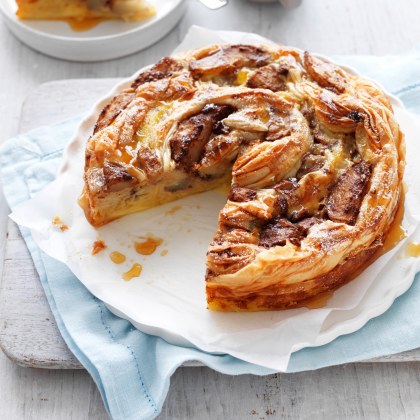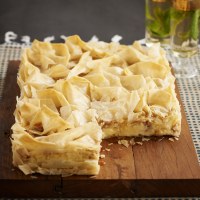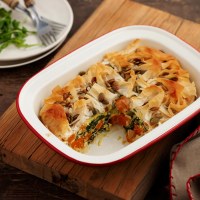Tips and tricks for working with filo pastry
Feeling unsure about where to start with filo? These frequently asked questions and five quick rules for using filo pastry will have you wielding flaky golden goodness with confidence! Scroll on to learn all about filo and get some great recipes too.
What is filo pastry and what is it made from?
Filo pastry is a thin flaky pastry used in sweet and savoury pies and pastries. It originated in Turkey, but you’ll commonly find it used in Greek, Middle Eastern and Balkan cooking in classic dishes such as spanakopita, baklava and börek.
The name filo comes from the Greek word for leaf. You might also see it spelled “phyllo”. It’s made with a mixture of flour, salt, water, vinegar and oil, which is rolled into a dough then kneaded and stretched (traditionally by hand) until it’s almost transparent. This is a time-consuming process, but thankfully nowadays filo is easily available at the supermarket.
Filo is a very delicate pastry that should be handled carefully for the best results. Learn how easy it is to use so you can enjoy its flaky, golden goodness at home!
The Five Rules for using Filo pastry
- Never handle filo with wet hands and keep your work surface dry. This will prevent breaks and tears in the pastry.
- Bake in a moderately hot oven around 180°C. Position it in the middle lower racks of your oven.
- Always bring pastry to room temperature (follow the instructions on the packet).
- Don't let your filo pastry dry out (get tips below).
- Save unused pastry by immediately placing back in the packaging. Secure firmly to prevent exposure to air and return to refrigerator.
What types of filo pastry are there?
You can find either fresh or frozen filo pastry, and most good supermarkets now stock both. Fresh filo pastry should be used within 2-3 weeks, whereas frozen filo pastry will keep well for up to 3 months.
Does filo pastry need to be at room temperature before using?
Yes, whether your filo is fresh or frozen, it must be brought to room temperature. If it’s still cold, you’ll have trouble unrolling it and separating the layers without breakage.
Follow the instructions on the packaging for best results. For frozen filo, leave it out at room temperature for approximately four hours. Fresh filo should be taken out of the fridge at least two hours before using.
How do you stop filo pastry drying out?
It’s important that you don’t let your filo pastry dry out! This can happen in just a couple minutes, and your filo will crack and become unusable. To stop it drying out, keep it in its packaging until you’re ready to use it, and prepare all your other ingredients first so it’s out of its packaging for a minimal amount of time.
While you’re using the filo pastry, cover the stack with a sheet of baking paper or a clean, dry tea towel followed by a cool damp tea towel. Make sure the pastry is completely covered.
Do you have to brush filo with butter?
Not necessarily, but butter is used traditionally and creates beautifully golden and crisp layers. If you don’t want to use butter, you still need to brush the pastry with another form of fat to help your pastry cook properly. Here are some alternatives:
- Olive oil – a popular choice for savoury pies and pastries.
- Cooking spray – lightly spray each layer with cooking spray for a lower fat alternative.
- Coconut oil – this is another great vegan alternative.
- Flavoured oils – choices such as garlic or chilli infused oil can add an extra dimension of flavour to your recipes.
How do you store used filo pastry?
Reroll any leftover filo pastry, return to its plastic bag and seal it tightly. Refrigerate and use within one week.
How long can you store filo pastry?
Unopened fresh filo pastry will usually last about two to three weeks in the fridge, check the best before date on the packaging. Frozen filo pastry will usually last about three months in the freezer.
Recipes that Use filo pastry
GET THE RECIPE: Mushroom and Lentil Curry Open Filo Pie by Rosella
This beautiful pie recipe uses filo pastry for the crust. Draping the pastry into the pan and then bulking up the base with extra folded pastry layers makes it easier to cut and serve your pie.
GET THE RECIPE: Punjabi Lemon Curry Fish Pie by Passage to India
This simple scrunching technique is one of the easiest ways to add a pie crust to this curried fish pie.
GET THE RECIPE: French Custard Apple Pie by Australian Eggs
This delightful dessert brings together layers of creamy custard and sweet, spiced apple slices, all encased in crispy, flaky filo pastry.



















